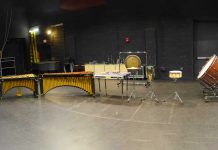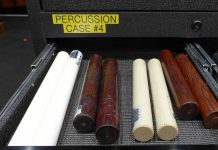How do you develop a percussion section so that they can make a significant musical contribution?
- DIRECTOR’S KNOWLEDGE of percussion pedagogy. (Technique classes, attend workshops, ask colleague’s or friends with percussion background for a lesson, percussion companies often have performance tips on their websites, etc…) Seek the knowledge – be proactive.
- MUSICAL INVOLVEMENT – what music ensembles are available? Do you integrate your percussion section into your band warmup? Do you have a percussion ensemble? Do you select music with challenging percussion parts? Do your students rotate around all of the percussion instruments?
- ATTITUDE!! Create an environment/culture of expectation – expect the same degree of musicianship from the percussion section that you do from the clarinets, trombones, etc…
- Musical contributions – don’t just hit the instruments, explore each instrument to produce the best sound (experiment with different mallets, heads, etc…)
- If you have a bad attitude toward the percussion section, they will sense the tension and respond in the same manner. Ignoring them will not make the problem go away. Set a high level of expectation and musicianship from your percussionists. They are musician’s too and need to be treated as such. Challenge them and involve them in the rehearsal process – let them know that their musical contribution is important to the success of the entire ensemble. Students should be encouraged to experience/perform on a variety of percussion instruments.
- ORGANIZATION!!
- Allocate a little time to spend with the percussion section to help them establish order.
- Reinforce the concept that each percussionist should help set up and take down equipment. Develop a daily routine and assign every student specific duties. Always post the music to be rehearsed in advance so the students can set up accordingly.
- Keep the percussion storage area organized and efficient – every instrument, stick, and mallet should have a specified home. Keep large equipment covered up and away from high traffic areas.
- Encourage your students to appreciate and care for the equipment, regardless of age or condition. Encourage them to buy their own stick bag, sticks and mallets. This is easily justified.
- Don’t permit other students to play around with the percussion equipment.
Design assignment charts so that each person knows what parts they are responsible for playing. Keep one copy posted in the percussion section and another copy with your scores. Be sure to rotate your percussionist’s around the various instruments. A good percussionist should be able to play all of the instruments in the family. Once you have determined a concert order, work out the choreography between instruments and transitions. Make sure they have trap tables or padded stands to place mallets and smaller instruments (music stands with black hand towels work well). This will minimize the chances of a small instrument or stick falling on the floor during a performance. By the time your dress rehearsal rolls around, your percussion section will be totally prepared and ready to roll! The time you invest in these areas will provide piece of mind.
BASIC TECHNIQUES/CREATING A GOOD MUSICAL SOUND!!
- Adjust instrument to each player as best as possible
SNARE DRUM
- Appropriate height, distance from drum (elbows at side – sticks in playing area)
- Position of snare drum strainer 12:00 to 6:00 to player
(quick, dry response over snares, slower snare response if not played over snares) - Sounds/tones:
- center – dry, lowest fundamental tone
- off-center – more resonant, full tone at the edge – thin tone – avoid playing too close to edge
- Playing at edge doesn’t make the sound soft!
- Grip = embouchure
- Matched – transfers to other instruments, easier to learn,
- Traditional – more difficult, drum set, better for mature students
- Fulcrum (pivot point) – where the stick should be held to obtain the greatest number of free bounces relaxed (rudimental) tighter (concert)
- Stroke – waving, bouncing tennis ball – Piston Motion
- Focus on natural rebound of the stick off of the head
- Stroke exercises by rote – focus on stroke development, sound
- Word phrases – (MISSISSIPPI HOT DOG)
- Sticking – emphasize alternating for beginners, helps develop the ability to use each hand equally well.
- don’t complicate note reading with (R’s, L’s)
- Strive for evenness of sound
- Rudiments = scales, arpeggios
- Rolls – students should demonstrate control of 16th notes before starting, start with multiple-bounce, introduce rudimental roll when control is established
- Roll base – gives students parameters for start and end of rolls
- Determined by tempo and dynamics
- Flams, Drags – difficult, need time to develop, exaggerate stick height
- Sticks – usually wooden tip, check for straightness, check for pitch, weight, General-purpose stick that produces a full-bodied sound.






